Getting It Right; Using Hue And Saturation To Correct Skin Tones
Accurate skin tones can be one of the most vexing problems facing the digital
portrait photographer. The human eye sees skin tones as memory colors--we
know what to expect, and when we see something different, our brain registers
the fact, making everything else in the image seem off color. The reverse is
also true though--get the skin colors right (or what our mind thinks is
right), and other colors in the image look accurate as well.
If you've spent anytime photographing people with a digital camera, you
probably noticed that skin tones are seldom right. Flash can also throw off
accurate color. Some cameras are better at this than others; for the most part,
point-and-shoot digicams deliver higher color saturation than digital SLRs.
It's not just an issue faced by digital photographers either. Scanning
traditional film will usually introduce some color cast to the process, but
with proper profiling, the amount of post-processing work to be done can be
greatly reduced.

The Hue/Saturation Fix
While a great deal of problems can be corrected with Curves, Color Balance and
other tools such as Variations and Levels, I've found that Hue and Saturation
is the best method of correcting skin tones. In my experience it gives much
finer control over individual color channels, and once you've used this
method, I don't think you'll ever look back.
1. The problem image in it's original form. The whole
image is a bit flat in color, but the skin tones have a very obvious red/magenta
tint to them. With just a few clicks, we can get the skin back to normal.
 |
|
|
2. The image of my daughter and son-in-law that I've selected here is typical for a digital camera with too much red/magenta in the skin. This was originally shot with a Nikon D100 with the sRGB color space. If your camera supports multiple color spaces, I suggest using Adobe RGB at capture. The sRGB palette tends toward more saturated colors, which typically mean more editing in the darkroom.
 |
|
|
Before starting out, the Info palette shows that we have a strong red tint
and a magenta cast that we'll want to bring down:
The Info palette in Photoshop is a quick way to check color balance. Just move
your mouse pointer over your image to see what value the image has. Here, we
want to see a more even balance between Cyan and Yellow with less Magenta.
3. To get started, choose Select>Color Range. I typically use a range of 20-30 for fuzziness. Much higher and the eye dropper picks up more than I want, lower values usually mean too much clicking to select the colors I need to modify. Click the + eye dropper in the middle, as you'll want each sample to add to the previous selection.
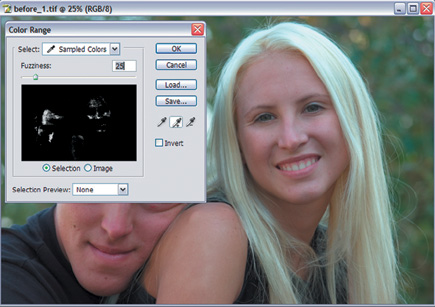 |
|
|
Using the Select Color Range command in Photoshop, we can build a selection by color much more accurately than possible with the Magic Wand tool. Be sure to set the eye dropper to the + to add to the selection with each click. In this case, the skin tones for my daughter and her husband were too red, so I'll select those areas of the image.
4. Click on the areas of skin that you want to adjust. As
you do so, the preview window will start to show more selected areas as seen
here:
After clicking on the areas we want to modify, the preview looks a bit like
a film negative. Once you have your selection right, clicking OK will close
the dialog and your selection will be active in the image window, ready for
adjustment.
 |
|
|
Once you've selected the range of color values to adjust, click OK and your image will display the selection guides.
5. Next, create a new adjustment layer--Layer>New Adjustment Layer>Hue/Saturation. This will put all your adjustments on a new layer and prevent changes to the original source image. Since different output choices, such as web and print, require different amounts of adjustment, keeping these adjustments on separate layers allows you to make modifications as needed without keeping multiple copies of the file.
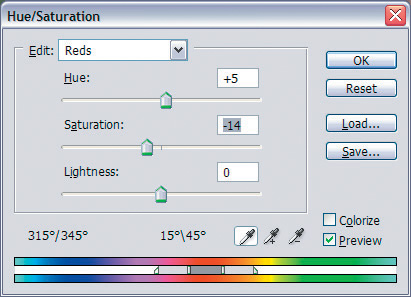 |
|
|
Depending on the color shift, you may need to make adjustments to the Master
channel. I normally don't make Saturation adjustments to Master, but will
make very slight (in the range of +1 to +5) adjustments to the Hue. In my sample
image, the red tones are too strong, so I select the Red channel and start lowering
the saturation level until it looks more neutral:
By selecting the Reds channel, I can affect only the red values within my selection.
Since I had too much red, I've lowered the saturation here. Typically,
a range of -5 to -15 is appropriate. After lowering the saturation, I felt that
I needed a slight boost to the hue so I raised it +5.
In this sample, I've lowered Saturation by -14. Once the reds were more
on target, the Hue seemed to need a boost and I raised it to +5. I find that
most Caucasian skin tones work best when lowering Saturation by -5 to -15. This
particular example had a very strong cast and needed more adjustment.
6. After making the saturation adjustments, the Info palette
shows a much closer balance in color. I've left the red a bit higher,
since my daughter would be unhappy without a bit of color in her cheeks:
After making the adjustments to the red channel, my color values are much closer
to correct with Cyan and Yellow values being nearly the same, and Magenta brought
down significantly.
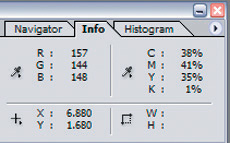 |
|
|
7. When finished, the image is much more neutral in the skin
tones, while leaving the other colors untouched.
The skin tones are much more accurate now that I've removed the color
cast. From this point, I'll do my general contrast and levels adjustments
to finish up the image and prepare it for print.
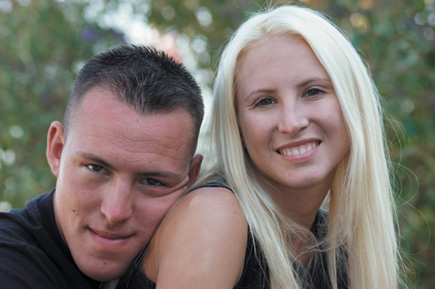 |
|
|
While there are no hard and fast rules as to color mixing, in general darker
skin tones, such as Asian or Hispanic, will have a higher percentage of yellow.
African American or Black is perhaps the hardest to correct since there is such
a wide range of skin tones that can be considered "correct." Lighter
skin tones here will be similar in range to the Hispanic samples, while darker
tones will be very close to equal in magenta and yellow, with cyan and black
increasing. Caucasian has the widest range, but in general yellow will be close
in value to cyan, with magenta the most prominent, which in this example you
can see holds true--Cyan is 38 percent, Yellow 35 percent, and Magenta
prominent at 41 percent.
8. In some cases, "perfectly accurate" may not
be the desired goal. Many women in particular want a more tanned look. In this
case, you'll want to keep the reds a bit higher, and adjusting Saturation
in the Master channel will achieve this:
Boosting the overall saturation to the image adds a little more pop. Since the
change is done in the Master channel this time, the entire image is affected
equally.
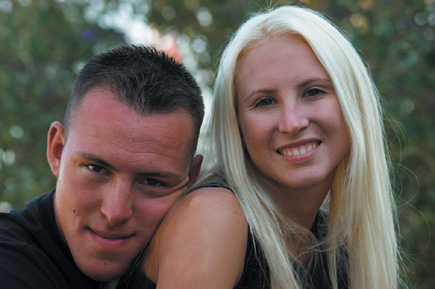 |
|
|
In this example, I raised the saturation on the Master channel to +9. I do
this edit after getting the color balance to what I feel is the correct tone
to avoid problems balancing out individual colors.
If you have a group of images that all need the same correction, you can simply
drag-and-drop your Hue/Saturation adjustment layer onto each image to quickly
apply the changes to each image.
Jon Canfield has been involved with digital imaging from its infancy. He has worked on software products for Microsoft such as Picture It and Digital Image Pro. Canfield has taught classes on digital workflow, and is currently co-authoring a book for Sybex "Photo Finish: The Digital Photographer's Guide to Printing, Showing and Selling Images" with Tim Grey. He can be reached at jon@joncanfield.com.












































